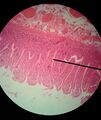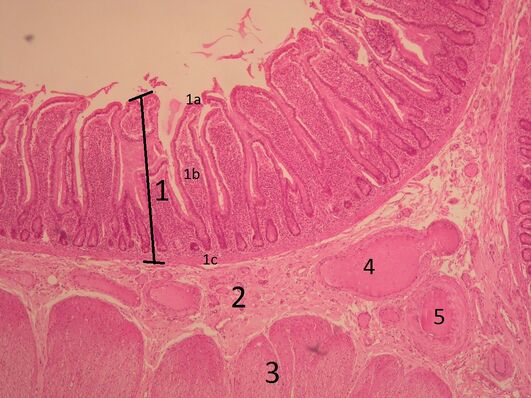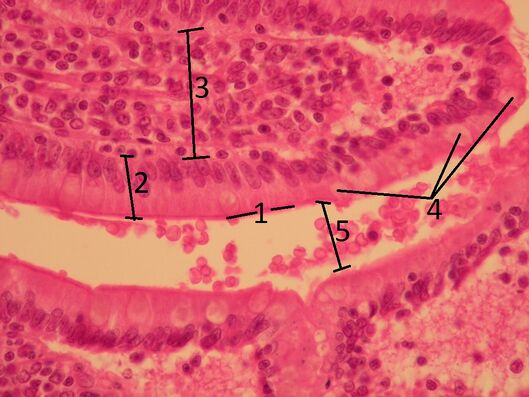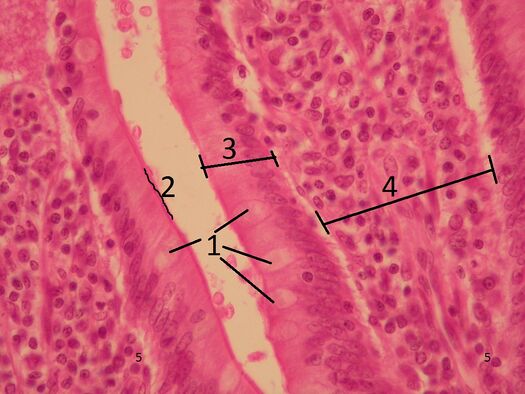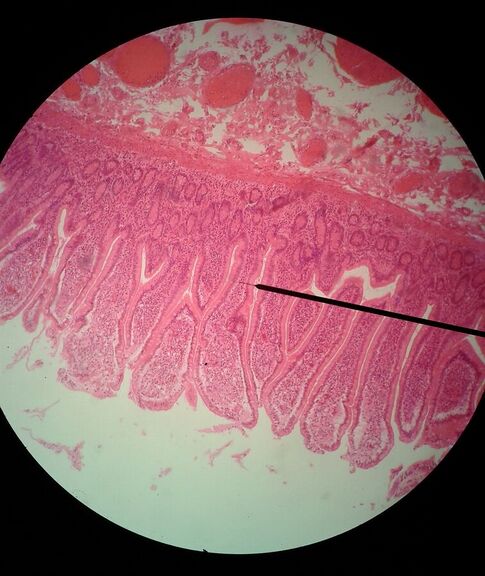Small intestine (specimen)
Small intestine B11[edit | edit source]
Overview[edit | edit source]
Specimen 1[edit | edit source]
Title: Small intestine (HE)
Description: The wall of the small intestine is composed of 4 layers: tunica mucosa, tunica submucosa, tunica muscularis externa, and tunica serosa. The mucous membrane (tunica mucosa) is raised in folds and contains intestinal glands - Lieberkühn's crypts. The tunica submucosa forms folds - plicae circulares (Kerckringi). The submucosa also contains a nerve plexus - the submucous plexus Meissneri. The smooth muscle forming the tunica muscularis externa is arranged in two layers - the inner circular and the outer longitudinal. Between them we find the nerve plexus plexus myentericus Auerbachi.
1 - tunica mucosa raised in numerous folds and crypts 1a - lamina epithelialis with a single-layered cylindrical epithelium with a brush border, occasional cup-shaped bb. (conf. colon); 1b - lamina propria forming the stroma of the folds; 1c - lamina muscularis mucosae; 2 - tunica submucosa, a rare collagenous tissue with numerous blood vessels; see further 3 - tunica muscularis externa, respectively the inner circular layer of muscle; 4 - vein; 5 - artery.
Specimen 2[edit | edit source]
Title: Small intestine - villus (HE)
Description: The epithelium lining the small intestine is single-layered cylindrical. In the epithelium, we find a number of specialized cells: enterocytes (absorptive cells - brush border and basolateral labyrinth), goblet cells (intraepithelial single-cell mucin-secreting glands), Paneth cells (production of lysozyme - non-specific immunity), M cells (over lymphatic nodules - transport of antigens - immunity), entero-endocrine cells (DNES- regulation of GIT function) and stem cells. Inside the villus is a rare collagenous tissue with smooth muscle cells and a number of cells of the immune system (plasma cells, lymphocytes, macrophages, etc.). Inside the villi, blood capillaries (fenestrated) and blind lymphatic capillaries begin.
1 - brush border of enterocytes 2 - enterocytes forming a single-layered cylindrical epithelium; 3 - villus stroma, lamina propria mucosae; 4 - goblet cells; 5 - space between two villi, note the erythrocytes, which here represent an artifact.
Specimen 3[edit | edit source]
Title: Intestinal villus epithelium (HE)
Description: The surface epithelium is predominantly composed of enterocytes, with occasional goblet cells (lighter cytoplasm) visible.
1 - Goblet cells; 2 - Brush border; 3 - Single-layered cylindrical epithelium, composed of enterocytes and goblet cells (occasionally other cell types); 4 - Lamina propria.
Specimen 4[edit | edit source]
Title: Small intestine - overview magnification (HE)
Description: Small intestine - tunica mucosa and tunica submucosa. The tunica mucosa is composed of epithelium (lamina epithelialis - single-layered cylindrical), lamina propria mucosae (rare collagenous tissue), lamina muscularis mucosae (smooth muscle that separates the lamina propria tissue from the submucosa tissue). Differences between different parts of the small intestine (duodenum, jejunum, and ileum) are not noticeable, except for the presence of mucinous Brunner's glands in the duodenum, which are gradual changes in the shape of villi, increasing numbers of goblet cells, and deepening of Lieberkühn's crypts. In the submucosa, in addition to the nerve plexus, blood and lymphatic vessels are also found.




